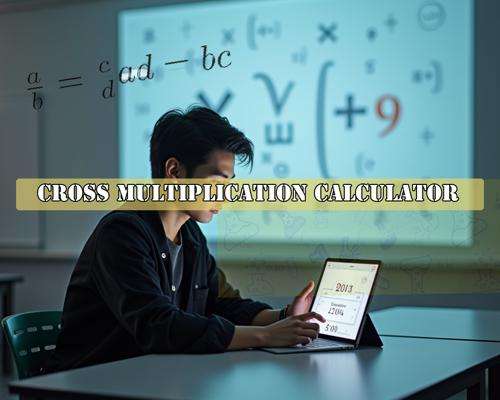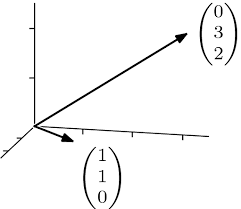Cross Multiplication Calculator
Instructions: Use this Cross Multiplication Calculator to either verify a proportionality, or to compute a missing value provided that the rest of them are provided. Please type in 3 or 4 values among A, B, C, and D in the proportion below.
\[\LARGE \displaystyle \frac{A}{B} =\frac{C}{D} \]About this Cross Multiplication Calculator
Using this tool will allow you to calculate a proportionality equation by using cross-multiplications. To this end, you need to provide three or four values for the list of \(A\), \(B\), \(C\) and \(D\) in:
\[ \displaystyle \frac{A}{B} = \frac{C}{D} \]Providing 3 values of the four will calculate the missing value, and providing the four values will tell you whether the proportion proposed is correct or not.
What is Cross Multiplication?
Cross multiplication is a method used to solve equations involving mainly fractions or proportions. This technique that allows you to find an unknown value by setting two ratios to be equal to each other, so then to multiply the numerator of one fraction by the denominator of the other, for the two fractions.
This process simplifies the process of solving for a variable in an equation, which can prove to be a crucial tool for your Algebra feats .

How to Use this Cross Multiplication Calculator?
This cross multiplication calculator is an online tool designed to simplify the process of solving proportions. Here's how you can use it:
- Enter the known values into the calculator's input fields.
- Click on the 'Calculate' button to solve for the unknown variable.
- The calculator will display the result, often with steps or explanations for clarity.
What is Involved when Cross Multiplying Expressions
These are the steps you need to conduct whenever you need to a cross multiplication:
- Step 1: Set up the equation: First, write down the two fractions or proportionality ratios you want to equate.
- Step 2: Cross multiply: Then, you multiply the numerator of the first fraction by the denominator of the second, and vice versa.
- Step 3: Set the products equal: Next, you check whether the two products are equal or not: they should be equal if the proportion equality is correct.
- Step 4: Solve for the unknown: Finally, isolate the variable on one side of the equation to find its value.
Why Does Cross Multiplication Work?
Cross multiplication works because it leverages the property of equivalent ratios. When two ratios are equal, the cross products of their numerators and denominators are also equal.
This principle stems from a fundamental property in Algebra, which ensures that we can multiply both sides of an equation by the something and the equality remains. This process of multiplying both sides of an equation by a number is called amplifying an equation. Based on this property, cross-multiplying is the same as amplifying the equation by both of the denominators.
Examples of Cross Multiplication
Let's look at some practical examples that will help solidify the concept:
- Example 1: Solve for \( x \) in \( \frac{3}{4} = \frac{x}{8} \). Here, \( 3 \times 8 = 4 \times x \), which simplifies to \( 24 = 4x \), so \( x = 6 \).
- Example 2: Now, if \( \frac{5}{6} = \frac{10}{x} \), then \( 5x = 6 \times 10 \), leading to \( x = 12 \).

Cross Multiplication with Variables
When dealing with variables, cross multiplication follows the same principle, because at its core, a variable is a placeholder for a number:
- If \( \frac{a}{b} = \frac{c}{d} \), then \( ad = bc \).
- Here, \( a \), \( b \), \( c \), and \( d \) can be variables or constants.
Advanced Techniques: Cross Multiplication in Calculus
In Calculus, cross multiplication can be used both in related rates and in solving differential equations. Also, when working in the context of limits:
- When dealing with limits, if \( \lim_{x \to a} \frac{b f(x)}{g(x)} = L \), you can cross multiply to find a suitable value of b that will lead to the desired limit \( L \).
- For differential equations, cross multiplication helps in separating variables, in case you have a separable ODE.
Common Mistakes in Cross Multiplication
Errors happen, but we can minimize their chance of happening when following certain basic rules. Here are some common errors to avoid:
- Not setting up the equation correctly: Ensure the fractions are correctly identified and set up properly before cross multiplying.
- Multiplying the wrong terms: Remember to CROSS multiply: Always multiply the numerator of one fraction by the denominator of the other.
- Ignoring signs: Pay attention to the signs of the numbers or variables involved.
How to Cross Multiply with Two Variables
When you have two variables in the equation, follow these steps:
- Set up the equation with the variables on both sides.
- Cross multiply to form an equation with one variable isolated.
- Solve for that variable, then substitute back to find the other.

Applications of Cross Multiplication in Real Life
Did you think that cross multiplying thing was something only from the math vacuum? Think again! Cross multiplication can be used in various real-life scenarios:
- Scaling Recipes: Adjusting ingredient quantities when cooking for different numbers of people.
- Map Reading: Converting distances on a map to real-world distances.
- Financial Calculations: Determining interest rates or investment returns.
Summary FAQ: Cross Multiplication Calculations
What is the cross product calculator?
The cross product calculator is a tool that computes the cross product of two vectors, which is different from cross multiplication used in proportions.
How do you cross multiply correctly?
Ensure you multiply the numerator of one fraction by the denominator of the other, and vice versa, then set the products equal to solve for the unknown.
Can cross multiplication be used with variables?
Yes, cross multiplication works with variables as long as the equation is set up correctly.
What are some common errors in cross multiplication?
Common errors include incorrect setup, multiplying the wrong terms, and ignoring signs.
How to cross multiply with 2 variables?
Set up the equation, cross multiply to isolate one variable, solve for it, then substitute back to find the other variable.
Explore More Multiplication Tools
If you're delving into the realm of multiplication, you might find our multiplication calculator useful for basic to complex multiplication tasks. For those interested in vector operations, understanding the cross product can provide insights into the orientation of vectors in space, which is crucial in fields like physics and engineering.
Moreover, if your work involves matrices, our matrix multiplication calculator can simplify the process of multiplying matrices, which is fundamental in linear algebra and computer graphics. Each of these tools enhances your understanding and application of multiplication in various mathematical contexts.





